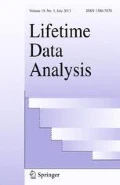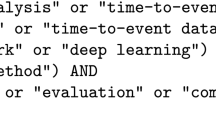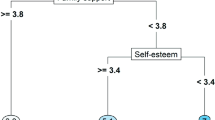Abstract
Frailty models are generally used to model heterogeneity between the individuals. The distribution of the frailty variable is often assumed to be continuous. However, there are situations where a discretely-distributed frailty may be appropriate. In this paper, we propose extending the proportional hazards frailty models to allow a discrete distribution for the frailty variable. Having zero frailty can be interpreted as being immune or cured (long-term survivors). Thus, we develop a new survival model induced by discrete frailty with zero-inflated power series distribution, which can account for overdispersion. A numerical study is carried out under the scenario that the baseline distribution follows an exponential distribution, however this assumption can be easily relaxed and some other distributions can be considered. Moreover, this proposal allows for a more realistic description of the non-risk individuals, since individuals cured due to intrinsic factors (immune) are modeled by a deterministic fraction of zero-risk while those cured due to an intervention are modeled by a random fraction. Inference is developed by the maximum likelihood method for the estimation of the model parameters. A simulation study is performed in order to evaluate the performance of the proposed inferential method. Finally, the proposed model is applied to a data set on malignant cutaneous melanoma to illustrate the methodology.







Similar content being viewed by others
References
Adamidis K, Loukas S (1998) A lifetime distribution with decreasing failure rate. Stat Probab Lett 39:35–42
Ata N, Özel G (2013) Survival functions for the frailty models based on the discrete compound Poisson process. J Stat Comput Simul 83:2105–2116
Barral AM (2001) Immunological studies in malignant melanoma: importance of tnf and the thioredoxin system. Linkoping, Sweden: Doctorate Thesis, Linkoping University
Barreto-Souza W, De Morais AL, Cordeiro GM (2011) The Weibull-geometric distribution. J Stat Comput Simul 81:645–657
Barriga GDC, Louzada F (2014) The zero-inflated Conway–Maxwell–Poisson distribution: Bayesian inference, regression modeling and influence diagnostic. Stat Methodol 21:23–34
Berkson J, Gage RP (1952) Survival curve for cancer patients following treatment. J Am Stat Assoc 47:501–515
Boag JW (1949) Maximum likelihood estimates of the proportion of patients cured by cancer therapy. J R Stat Soc B 11:15–53
Cancho VG, Louzada F, Ortega EM (2013) The power series cure rate model: an application to a cutaneous melanoma data. Commun Stat Simul Comput 42:586–602
Caroni C, Crowder M, Kimber A (2010) Proportional hazards models with discrete frailty. Lifetime Data Anal 16:374–384
del Castillo J, Pérez-Casany M (2005) Overdispersed and underdispersed Poisson generalizations. J Stat Plann Inference 134:486–500
Chahkandi M, Ganjali M (2009) On some lifetime distributions with decreasing failure rate. Comput Stat Data Anal 53:4433–4440
Chen MH, Ibrahim JG, Sinha D (1999) A new Bayesian model for survival data with a surviving fraction. J Am Stat Assoc 94:909–919
Choo-Wosoba H, Levy SM, Datta S (2015) Marginal regression models for clustered count data based on zero-inflated Conway–Maxwell–Poisson distribution with applications. Biometrics 2:606–618
Consul PC, Jain GC (1973) A generalization of the Poisson distribution. Technometrics 15:791–799
Cordeiro GM, Cancho VG, Ortega EMM, Barriga GDC (2016) A model with long-term survivors: negative binomial Birnbaum–Saunders. Commun Stat Theory Methods 45:1370–1387
Coskun K (2007) A new lifetime distribution. Comput Stat Data Anal 51:4497–4509
Cox DR (1972) Regression models and life-tables. J R Stat Soc Ser B 34:187–220
Cox DR, Hinkley DV (1979) Theoretical statistics. Chapman & Hall/CRC, Washington DC
Duchateau L, Janssen P (2008) The frailty model. Springer, New York
Dunn PK, Smyth GK (1996) Randomized quantile residuals. J Comput Gr Stat 5:236–244
Efron B (1979) Bootstrap methods: another look at the jackknife. Ann Stat 7:1–26
Efron B (1981) Censored data and the bootstrap. J Am Stat Assoc 76:312–319
Efron B, Tibshirani R (1986) Bootstrap methods for standard errors, confidence intervals, and other measures of statistical accuracy. Stat Sci 1:54–75
Eudes AM, Tomazella VLD, Calsavara VF (2013) Modelagem de sobrevivência com fração de cura para dados de tempo de vida weibull modificada. Rev Bras Biom 30:326–342
Gupta PL, Gupta RC, Tripathi RC (1995) Inflated modified power series distributions with applications. Commun Stat Theory Methods 24:2355–2374
Hougaard P (1986) A class of multivariate failure time distributions. Biometrika 73:671–678
Hougaard PA (1984) Life table methods for heterogeneous populations: distributions describing the heterogeneity. Biometrika 71:75–83
Ibrahim JG, Chen MH, Sinha D (2005) Bayesian survival analysis. Springer, New York
Kirkwood JM, Ibrahim JG, Sondak VK, Richards J, Flaherty LE, Ernstoff MS, Smith TJ, Rao U, Steele M, Blum RH (2000) High- and low-dose interferon alfa-2b in high-risk melanoma: first analysis of intergroup trial E1690/S9111/C9190. J Clin Oncol 18:2444–2458
Li CS, Taylor JMG, Sy JP (2001) Identifiability of cure models. Stat Probab Lett 54:389–395
Li H, Zhong X (2002) Multivariate survival models induced by genetic frailties, with application to linkage analysis. Biostatistics 3:57–75
Maller R, Zhou X (1996) Survival analysis with long-term survivors. Wiley, New York
Milani EA, Tomazella VLD, Dias TCM, Louzada F et al (2015) The generalized time-dependent logistic frailty model: an application to a population-based prospective study of incident cases of lung cancer diagnosed in Northern Ireland. Braz J Probab Stat 29:132–144
Moger TA, Aalen OO, Halvorsen TO, Storm HH, Tretli S (2004) Frailty modelling of testicular cancer incidence using scandinavian data. Biostatistics 5:1–14
Morel JG, Neerchal NK (2012) Overdispersion models in SAS. SAS Institute Inc., Cary
Morita LHM, Tomazella VL, Louzada-Neto F (2016) Accelerated lifetime modelling with frailty in a non-homogeneous Poisson Process for analysis of recurrent events data. Qual Technol Quant Manag 15:1–21
Ortega EMM, Cordeiro GM, Campelo AK, Kattan MW, Cancho VG (2015) A power series beta weibull regression model for predicting breast carcinoma. Stat Med 34:1366–1388
Press WH, Flannery BP, Teukolsky SA, Vetterling WT, Kramer PB (2007) Numerical recipes: the art of scientific computing. Cambridge University Press, New York
R Development Core Team (2010) R: A language and environment for statistical computing. R Foundation for statistical computing, Vienna, Austria. http://www.R-project.org
Rodrigues J, Cancho VG, de Castro M, Louzada-Neto F (2009) On the unification of long-term survival models. Stat Probab Lett 79:753–759
Samani EB, Amirian Y, Ganjali M (2012) Likelihood estimation for longitudinal zero-inflated power series regression models. J Appl Stat 39:1965–1974
Santos DM, Davies RB, Francis B (1995) Nonparametric hazard versus nonparametric frailty distribution in modelling recurrence of breast cancer. J Stat Plann Inference 47:111–127
Sun FB, Kececloglu DB (1999) A new method for obtaining the ttt plot for a censored sample. In: Proceedings on annual reliability and maintainability symposium, IEEE, pp 112–117
Tahmasbi R, Rezaei S (2008) A two-parameter lifetime distribution with decreasing failure rate. Comput Stat Data Anal 52:3889–3901
Tsodikov AD, Ibrahim JG, Yakovlev AY (2003) Estimating cure rates from survival data: an alternative to two-component mixture models. J Am Stat Assoc 98:1063–1078
Vaupel JW, Manton KG, Stallard E (1979) The impact of heterogeneity in individual frailty on the dynamics of mortality. Demography 16:439–454
Van den Broek J (1995) A score test for zero inflation in a Poisson distribution. Biometrics 51:738–743
Wienke A (2010) Frailty models in survival analysis. Chapman and Hall/CRC, New York
Xue X, Brookmeyer R (1997) Regression analysis of discrete time survival data under heterogeneity. Stat Med 16:1983–1993
Yakovlev A, Yu AB, Bardou VJ, Fourquet A, Hoang T, Rochefodiere A, Tsodikov AD (1993) A simple stochastics model of tumor recurrence an its aplications to data on premenopausal breast cancer. In: de Biométrie SF (ed) Biometrie et Analyse de Donnes Spatio-Temporelles No 12, B, France, pp 33–82
Yakovlev AY, Tsodikov AD (1996) Stochastic Models of tumor latency and their biostatistical applications. World Scientific, New Jersey
Acknowledgements
This work was partially funded by the Brazilian institutions FAPESP, CAPES and CNPq.
Author information
Authors and Affiliations
Corresponding author
Additional information
Publisher's Note
Springer Nature remains neutral with regard to jurisdictional claims in published maps and institutional affiliations.
Appendix: Calculation details for the observed information matrix
Appendix: Calculation details for the observed information matrix
The components of the observed information matrix, \({\varvec{J}}({\varvec{\vartheta }}),\) are derived in the form
and
where
and
Rights and permissions
About this article
Cite this article
Cancho, V.G., Macera, M.A.C., Suzuki, A.K. et al. A new long-term survival model with dispersion induced by discrete frailty. Lifetime Data Anal 26, 221–244 (2020). https://doi.org/10.1007/s10985-019-09472-2
Received:
Accepted:
Published:
Issue Date:
DOI: https://doi.org/10.1007/s10985-019-09472-2




